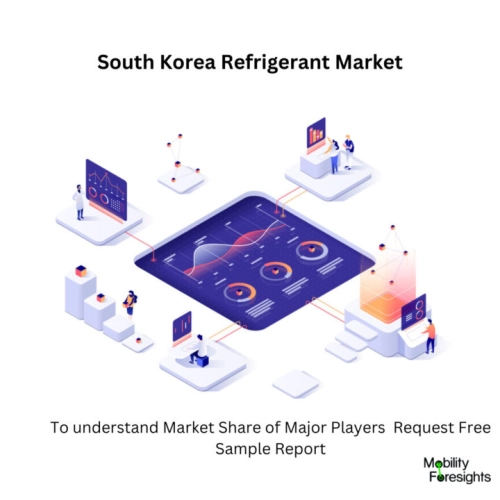
- Get in Touch with Us

Last Updated: Apr 26, 2025 | Study Period: 2023-2030
Refrigerant usage is governed in South Korea to guarantee sustainability and environmental protection. To comply with international norms and regulations, alterations have been made to the particular refrigerants utilized in the nation.
The following are some crucial details about refrigerants in South Korea: Compliance with the Montreal Protocol: As a signatory to the Montreal Protocol, South Korea is committed to eliminating ozone-depleting compounds and lowering greenhouse gas emissions from refrigerants. The protocol specifies precise goals and schedules for the discontinuation of controlled substances.
Hydrochlorofluorocarbons (HCFCs) are being phased out in South Korea in compliance with the Montreal Protocol. Because of their potential to harm the ozone layer, HCFCs are gradually being phased out of use. To restrict the manufacture, import, and use of HCFCs, the government has put restrictions in place.
Transition to HFCs with Lower GWP: In South Korea, hydrofluorocarbons (HFCs) are frequently employed as HCFC replacements. There is, however, a rising emphasis on switching to HFCs with lower GWPs or alternative refrigerants that have even fewer environmental effects due to their high global warming potential (GWP).
Adoption of Natural Refrigerants: South Korea has demonstrated a dedication to promoting natural refrigerants with very low or zero GWPs, such as carbon dioxide (R-744), ammonia (R-717), and hydrocarbons (R-290, R-600a). These natural refrigerants are utilized more frequently in a variety of applications because they are thought to be more environmentally benign.

The South Korea refrigerant market accounted for $XX Billion in 2022 and is anticipated to reach $XX Billion by 2030, registering a CAGR of XX% from 2023 to 2030.
The Chemours Company (Chemours), a global chemistry company with market-leading fluoroproducts, launched that Korea's refrigerant, E-mart, has chosen to use Opteon XP40 (R-449A), its low global warming potential (GWP) hydrofluoroolefin (HFO) refrigerant, in their refrigeration systems. A crucial step for E-mart to achieve its commitment to sustainability is the introduction of low GWP refrigerants. The use of Opteon XP40 refrigerant will increase energy efficiency at E-mart stores around Asia Pacific, as well as provide additional benefits to end users like higher product quality. E-mart is rapidly growing and plans to have more than 200 outlets using OpteonTM XP40 refrigerant by the end of the year.
THIS REPORT WILL ANSWER FOLLOWING QUESTIONS
| Sl no | Topic |
| 1 | Market Segmentation |
| 2 | Scope of the report |
| 3 | Abbreviations |
| 4 | Research Methodology |
| 5 | Executive Summary |
| 6 | Introduction |
| 7 | Insights from Industry stakeholders |
| 8 | Cost breakdown of Product by sub-components and average profit margin |
| 9 | Disruptive innovation in the Industry |
| 10 | Technology trends in the Industry |
| 11 | Consumer trends in the industry |
| 12 | Recent Production Milestones |
| 13 | Component Manufacturing in US, EU and China |
| 14 | COVID-19 impact on overall market |
| 15 | COVID-19 impact on Production of components |
| 16 | COVID-19 impact on Point of sale |
| 17 | Market Segmentation, Dynamics and Forecast by Geography, 2023-2030 |
| 18 | Market Segmentation, Dynamics and Forecast by Product Type, 2023-2030 |
| 19 | Market Segmentation, Dynamics and Forecast by Application, 2023-2030 |
| 20 | Market Segmentation, Dynamics and Forecast by End use, 2023-2030 |
| 21 | Product installation rate by OEM, 2023 |
| 22 | Incline/Decline in Average B-2-B selling price in past 5 years |
| 23 | Competition from substitute products |
| 24 | Gross margin and average profitability of suppliers |
| 25 | New product development in past 12 months |
| 26 | M&A in past 12 months |
| 27 | Growth strategy of leading players |
| 28 | Market share of vendors, 2023 |
| 29 | Company Profiles |
| 30 | Unmet needs and opportunity for new suppliers |
| 31 | Conclusion |
| 32 | Appendix |